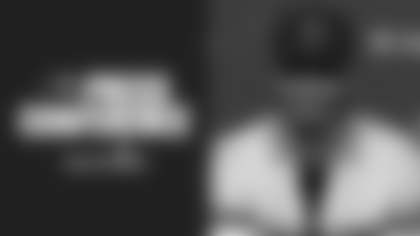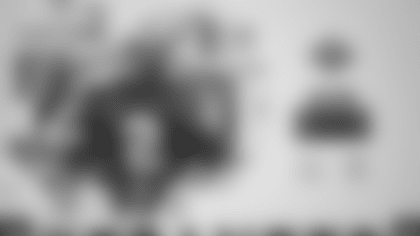Mike Evans heads into the 2021 season needing "only" 10 touchdowns to become the Tampa Bay Buccaneers' all-time leader in that category. He has 62 so far and Mike Alstott finished his incredible career with 71 touchdowns. There was a time that Alstott's franchise record looked like it would stand indefinitely; after all, the previous record by James Wilder was 46 and Alstott left that far back in the dust.
I put the word "only" in quotation marks because 10 touchdowns is actually an awful lot to score in one season. In Buccaneers history, over 45 seasons so far, it's only been done a dozen times, by eight different players. However, Evans has done it three times in seven seasons and owns three of the four campaigns in team annals with 12 or more touchdowns scored. He's also finished with eight on two other occasions. Ten touchdowns is a lot in one season, but if anyone is going to do it in red and pewter, it's probably going to be Mike Evans.
Alstott's touchdown mark is the only one among the "counting" all-time franchise records that is in danger of falling in 2021, unless you count Evans padding his other team-leading totals in receptions (532) and receiving yards (8,262). In fact, some of those records are going to stand for a very long time, if they're ever challenged at all. Let's take a quick look at a dozen prominent all-time counting records in Bucs history in terms of two things: how close the current closest challenger is and how close anyone got to the record (whether before or after it was set).
For instance, concerning the touchdowns record, Evans is the answer to both questions as he has climbed to 87% of Alstott's total. Here are the other 11:
Games Played
- Record: Ronde Barber, 241
- Current Challenger: Lavonte David, 137, 56.8%
- Second Place: Derrick Brooks, 224, 92.9%
Games Started
- Record: Ronde Barber, 232
- Current Challenger: Lavonte David, 137, 59.1%
- Second Place: Derrick Brooks, 221, 95.3%
Points Scored
- Record: Martin Gramatica, 592
- Current Challenger: Mike Evans, 380, 64.2%
- Second Place: Michael Husted, 502, 84.8%
Rushing Yards
- Record: James Wilder, 5,957
- Current Challenger: Ronald Jones, 1,746, 29.3%
- Second Place: Mike Alstott, 5,088, 85.4%
Receptions
- Record: Mike Evans, 532
- Current Challenger: Chris Godwin, 244, 45.9%
- Second Place: James Wilder, 430, 80.8%
Receiving Yards
- Record: Mike Evans, 8,266
- Current Challenger: Chris Godwin, 3,540, 42.8%
- Second Place: Mark Carrier, 5,018, 60.7%
Passing Yards
- Record: Jameis Winston, 19,737
- Current Challenger: Tom Brady, 4,633, 23.5%
- Second Place: Vinny Testaverde, 14,820, 75.1%
Tackles
- Record: Derrick Brooks, 2,198
- Current Challenger: Lavonte David, 1,125, 51.2%
- Second Place: Ronde Barber, 1,428, 78.8%
Sacks
- Record: Lee Roy Selmon, 78.5*
- Current Challenger: Jason Pierre-Paul, 30.5, 38.9%
- Second Place: Warren Sapp, 77.0, 98.1%
(* Though sacks did not become an official NFL statistic until 1982, the Buccaneers count Selmon's pre-'82 sacks in terms of the franchise record.)
Interceptions
- Record: Ronde Barber, 47
- Current Challenger: Lavonte David, 12, 25.5%
- Second Place: Donnie Abraham, 31, 66.0%
Takeaways? Well, I just typed the words "Ronde Barber" a lot. What an impact he made on this franchise, in so many ways. The receptions and receiving yardage records and challengers don't really mean a lot with both Evans and Godwin still playing at the same time, but Evans can continue to pad his extend his yardage lead over former record-holder Mark Carrier. At his current rate of 125 tackles per season, David would have to play 8 and a half years to catch Brooks for the top spot, but he could surpass Barber for second in less than two and a half.
Now, on to your questions.
A reminder that you can send questions to me anytime you want on Twitter (@ScottSBucs) and they're easier to find if you include the hashtag #SSMailbagBucs. We are also now soliciting questions each week on our Instagram page; look for that story on Wednesdays. As always, if you want to get a longer question into the mailbag and would prefer to email your question, you can do so to tbbsocial@buccaneers.nfl.com.
As we get closer to the draft and wrap up free agency, what is our biggest remaining roster gap?
- @levi_chrisemer (via Instagram)
I think I've answered some form of this question at least once already, but that was even before the Bucs continued their signings and re-signings with quarterback Ryan Griffin, running back Giovani Bernard, defensive lineman Steve McLendon and cornerback Ross Cockrell. I don't mean to be repetitive or overly confident, but there really isn't much the Bucs have left to do to fill out a depth chart…and one that can compete for a championship, at that.
Though a few of their own free agents remain in that category – most notably wide receiver Antonio Brown – the Bucs have only officially lost four players from their 2020 team to free agency so far. Those are safety Andrew Adams, tight end Antony Auclair, tackle Joe Haeg and cornerback Ryan Smith. That's not much, and there are viable internal candidates to potentially replace all of them.
For instance, with the return of Ross Cockrell the Bucs have a solid top four cornerbacks and could develop Herb Miller, whom the coaching staff is high on, to replace Smith as the fifth corner. Smith essentially only played on special teams as it was. Brad Seaton, who opted out last year, could replace Haeg as the fourth tackle, though I expect the team to add several more options. Tanner Hudson and Codey McElroy are interesting options at tight end and 2020 undrafted rookie Javon Hagan could add depth at safety.
I guess one obvious gap is quarterback, which remains true even after the return of Griffin on Tuesday. The Bucs are almost certain to take four to camp and keep three on the 53-man roster, so by sheer numbers some additions are necessary there. That might even include a developmental player the Bucs find in the draft.
Otherwise, with all 22 starters from the Super Bowl team coming back, we're really just talking about depth here, and future concerns. The Bucs have only Kevin Minter behind the awesome inside linebacker duo of Lavonte David and Devin White. They also only have one player with any NFL experience backing up the interior offensive linemen, that presumably being Aaron Stinnie if Alex Cappa returns to his pre-injury spot as the starting right guard. The edge-rushing depth could be considered a little shallow, depending upon what you think of Anthony Nelson, Cam Gill and Quinton Bell. And I suppose another receiver would be nice if Brown does not return, though it would also be interesting to see what Scotty Miller and Tyler Johnson would do with more snaps.
Seriously, I'm looking for holes and not really finding much. Now of course, things never work out exactly as planned, and the picture could look a little different in early September. But for now, on paper at least, the roster looks solid top to bottom.
With the current cap situation the way it is, how many cuts should we expect before the draft?
- @krish_hassie (via Instagram)
Well, it ain't good. That is, if by "good" we mean "having a lot of it."
The Buccaneers don't officially disclose things like their current cap space, but there are several web sites that track that information. Over the Cap has the Bucs with $1,079,811 of cap space, the third-lowest figure in the league. It's an NFC South thing, because the two teams below the Bucs are the Falcons and Saints. Spotrac also has the Bucs with the third-lowest cap space margin, but with a figure of $1,877,637 and ahead of the Saints and Bears. Neither figure has probably been adjusted yet to include Tuesday's contract with Ryan Griffin.
It doesn't really matter which of those two figures is correct or even if either of them are right on the money. They're surely in the ballpark, which means the Bucs have very little room to work with at the moment.
Those last three words are important. The Bucs may not have much cap space at the moment but there are ways to create more. The Buccaneers will have to do at least some of that in order to free up enough space to accommodate whatever their slotted draft picks count against the cap.
Does that mean cutting some players? Not necessarily. The most common way to create space is actually something that works out well for players: Renegotiating contracts. Generally that means taking a sum of money that was originally going to be paid as salary during the upcoming season and converting it into a signing bonus or some other kind of bonus. Doing so takes a player's 2021 cap hit and spreads it out over multiple years, thereby reducing it in the current year.
As a very simplified example, say a player is in the first year of a four-year contract and he is due to be paid a salary of $21.075 million in 2021. In the renegotiated deal, the player gets a $1.075 million salary for 2021 and a $20 million signing bonus. That's good for him – he gets his money right on the spot. And since signing bonuses are prorated over the length of the contract for salary cap calculation, his 2021 cap hit is reduced from $20 million to $6.075 million (his 2021 salary plus $5 million prorated bonus).
Theoretically there is some limit to how many of these you can do, and a team has to also figure out actual cash flow, but generally there is a way to get it done. The Buccaneers will get it done in this case. Count on it.
I'm not saying cuts are out of the question; cuts happen every year with every team and sometimes they are salary-cap related. The Saints just had to make a lot of those last month, but that was after years of giving out deals that pushed cap hit down the road. The nearly unprecedented reduction of the salary cap from 2020 to 2021, caused by the pandemic, only made the situation tougher for the Saints. But the Bucs aren't trying to dig out of a hole in order to be cap compliant by the start of a new season. They have already signed back almost all of their free agents and are still under the cap limit, if only by a smidge. Now it's just a matter of clearing one hurdle at a time to stay under the cap, and I don't think that's going to necessitate a roster purge.
Scott,
I love Antoine Winfield…he's already one of my favorite current Bucs. I remember wondering why we were drafting a safety in the second round last year, but now I get it. I think he's going to be great and he's already a lot of fun to watch. He should have gotten more attention in the defensive rook of the year award, imo, but just to be in the conversation as a second round pick is pretty great. How do you think he rates compared to some of the other second round picks in team history when it comes to how good they were as rookies? Thanks!
Kevin L. in Bradenton (via email)
Yeah, I bet we see a good amount of Winfield jerseys when we start filling Raymond James Stadium again. He really was remarkable as a rookie and I think he's just getting started. The Bucs wanted another big-playmaker in their secondary, and they found one.
Anyway, Winfield has some second-round company in the Bucs' current secondary who were at least solid rookies, if not better. Sean Murphy-Bunting (2019) started 10 games and led the team with three interceptions. Carlton Davis (2018) started 12 games but did not have a pick as a rookie. I'd put Winfield's rookie season above both of those.
It's kind of hard to judge how good a rookie offensive lineman is, unless he does so good that everyone notices by season's end that he's barely given up any sacks or committed any penalties. You know, like Tristan Wirfs, who doesn't qualify here because he was a first-round pick. Anyway, that's what makes it hard to rank the likes of Donovan Smith and Ali Marpet (2015), Jeremy Trueblood (2006), Randy Grimes (1983) and Greg Roberts (1979). They were all instant or almost-instant starters, though, which is saying something.
I do remember Doug Williams once telling me how good Roberts was in 1979 and how important he was to the team's first playoff run, so I think I'll put him on the short list. Roberts was also selected for Pro Football Weekly's all-rookie team that year. (To be fair, both Smith and Marpet were Pro Football Writers Association all-rookie picks, too, as was 2007 second-round guard Arron Sears.)
Both Shaun King (1999) and Errict Rhett (1994) had to wait pretty long into their rookie seasons to get their shots, which keeps their numbers down a bit, but Rhett still managed to crack 1,000 rushing yards in 1994. The latter deserves consideration but he's not on my list of final candidates. Cornerback Ricky Reynolds and linebacker Winston Moss (1987) were both solid as rookies but didn't really blossom until their second seasons. James Wilder (1981) started out as a fullback and had 877 yards from scrimmage, which is good but not overwhelming. His teammate, wideout Kevin House (1980) was another player who emerged as a standout in his second season.
So I've already got Roberts in my final group, and here are three more to join him: linebacker Lavonte David (2012), fullback Mike Alstott (1996) and linebacker David Lewis (1977).
David walked right into the NFL as the great player we now know him to be. He started all 16 games as a rookie and racked up 139 tackles, 20 tackles for loss (!), 2.0 sacks, one interception and four passes defensed. The PFWA put him on their all-rookie team.
Alstott did not make an all-rookie team (they might not have had a specific fullback spot) and his yards from scrimmage total of 934 in 1996 isn't a ton more than what I noted for Wilder in 1981). But he did lead the team with 65 catches, and he scored six touchdowns and generally started in on what would become an unforgettable career highlight reel of second and third-effort plays. I could be a bit biased on this one, having seen it in person.
Lewis played in all 14 games in 1977 and started 13 of them, putting up some gaudy numbers, including 96 tackles, 5.0 sacks, two interceptions and a team-leading six pass deflections. He was an all-rookie choice by PFW, too.
So my top group would be Roberts, David, Alstott and Lewis, with apologies to a couple probably deserving offensive linemen and maybe Rhett. I think Winfield is comfortably in that group.
And to be clear – this is just in terms of how they performed as rookies. There are plenty of amazing second-round performers in team history, career-wise, including a bunch of the players discussed above.
Will Ryan Griffin be our next starting quarterback when Tom is done or does he give us a solid backup option moving forward?
- @domkruse_04
That doesn't sound a true either/or question to me. I mean, at the current moment the answer is obviously the latter. Griffin has returned to continue backing up Tom Brady, who is under contract for the next two years and surely expected to remain the starter all that time.
As with financial information like cap space, the Buccaneers do not officially disclose the terms of contracts when they sign or re-sign a player in most cases. However, you can generally find outside reports as to the length and money, and in this case Griffin's deal is reported to be one year. I'm not confirming that on behalf of the team in this space, but if we accept those reports as likely being true than Griffin's deal doesn't even keep him with the team past Brady's likely tenure as the starter.
Which is not to say the Buccaneers don't think highly of Griffin. This is the third time that they have re-signed him since his original arrival as a waiver claim in September of 2015. The second two of those three deals have been done since the arrival of Bruce Arians and his coaching staff. Arians kept Griffin around before even coaching him in a single game because Griffin's previous deal was signed in March of 2019, just a couple months after Arians arrived. Yes, through six years with the team Griffin has – almost remarkably – only thrown four regular-season passes, all in one game in 2019, but in a way that makes his staying power even more impressive. Several different coaching staffs have talked about how Griffin consistently impresses on the practice field, and I guess we have to take that at face value at this point.
All of that said, I don't think his re-signing this week should be seen as a sign that he is the main plan to succeed Brady in a couple years. The fact of the matter is the Buccaneers had zero quarterbacks on the roster behind Brady until that deal was done. They had to add at least one, and probably three by the start of training camp, and it certainly makes sense to bring back a veteran who knows the system well and has the coaches' trust. For the same reason, it wouldn't surprise me if Blaine Gabbert is eventually re-signed, too, presuming that's what he wants to do.
To me, the far more likely options for the eventual successor to Brady are the acquisition of another proven veteran starter or a draft pick in the next year or two. I wouldn't be surprised to see the Buccaneers take a quarterback in this year's draft, though I doubt it will be in the first round. But if they spent a Day Two pick on a passer it would be reasonable to assume they hope they will be able to develop him into a future starter. And, potentially, the Bucs could be in the market for another first-round quarterback in the next couple years, although they also hope to continue getting picks that are late enough in the first round to make that hard to do.



































